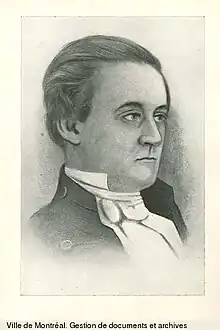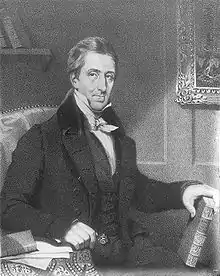Lewis Thomas Drummond | |
|---|---|
 | |
| Member of the Legislative Assembly of the Province of Canada for Montreal (two-member constituency) | |
| In office April 17, 1844 – September 23, 1844 (by-election) | |
| Preceded by | Benjamin Holmes |
| Succeeded by | George Moffatt Clément-Charles S. de Bleury |
| Member of the Legislative Assembly of the Province of Canada for Portneuf | |
| In office 1844–1847 | |
| Preceded by | Thomas Cushing Aylwin |
| Succeeded by | Antoine Juchereau Duchesnay |
| Personal details | |
| Born | May 28, 1813 Coleraine, Ireland, United Kingdom |
| Died | November 24, 1882 (aged 69) Montreal, Quebec |
| Spouse | Josephte-Elmire Debartzch |
| Relations | Pierre-Dominique Debartzch (father-in-law) Alexandre-Édouard Kierzkowski (brother-in-law) |
| Children | 2 sons |
| Education | Séminaire de Nicolet |
| Profession | Lawyer |
Lewis Thomas Drummond (May 28, 1813 – November 24, 1882) was a lawyer, political figure, and judge in Lower Canada (now Quebec).
Family and early life
Drummond was born in Coleraine, County Londonderry, Ireland in 1813, the son of Lewis Drummond and Susan Harkin. His father was a prominent attorney in Ireland, but he died while Lewis Thomas was young. His mother emigrated to Lower Canada in 1825, bringing Lewis Thomas with her.[1][2]
He studied at the Séminaire de Nicolet, then articled with a leading Tory lawyer in Montreal, Charles Dewey Day. Drummond was called to the bar of Lower Canada in 1836. He set up practice in Montreal and defended a number of persons involved in the Lower Canada Rebellions of 1837 and 1838.[1][2]
In 1842, he married Josette-Elmire Debartzch. Their two sons became Jesuits. By his marriage, Drummond gained entrée to the French-Canadian conservative élite: Josette-Elmire was the daughter of Pierre-Dominique Debartzch and Josette de Saint-Ours, the owners of the seigneury of Saint-François (also known as Saint-Charles) and the seigneury of Cournoyer. Pierre-Dominique Debartzch had been elected to the Legislative Assembly of Lower Canada at the same time as Louis-Joseph Papineau, and like him supported the Parti canadien. Another of Debartzch's daughters married Alexandre-Édouard Kierzkowski, who was later elected to the Legislative Assembly of the Province of Canada[1][2]
Political career
The quest for responsible government: 1841–1847
.jpg.webp)


After the suppression of the Lower Canada Rebellions, Drummond supported the moderate reform position of Louis-Hippolyte LaFontaine, who was campaigning for the implementation of responsible government, as recommended by Lord Durham in the Durham Report. Under that principle, the Executive Council would be drawn from the group which had majority support in the elected Legislative Assembly, rather than leaving the government in the hands of the Governor General, appointed by the British government. Drummond became one of LaFontaine's party managers in Montreal, working to build up popular support for LaFontaine's leadership of the French-Canadian Group.[1][3][4][5]
In 1843 and 1844 a split developed in the French-Canadian Group, between the older members led by Denis-Benjamin Viger, who had their roots in the pre-Rebellion politics, and the newer reform members, led by LaFontaine and his campaign for responsible government. When one of the members from Montreal resigned his seat in 1844, Drummond stood for election against Viger's favoured candidate. Fluently bilingual, Drummond was able to appeal to French-Canadian voters. He was also able to gain the votes of Irish-Catholic workers, and won the hard-fought by-election. His victory was seen as a significant shift in support away from the older wing of the reformers, and a popular affirmation of LaFontaine's policy.[1][2][5]
Drummond did not get a chance to sit in the Assembly in his Montreal seat. The Governor General, Sir Charles Metcalfe, advised by Viger and William Henry Draper from Upper Canada, decided that he would not recall the existing Parliament, which had supported LaFontaine and Robert Baldwin, the leader of the Upper Canada reformers. Instead, Metcalfe dissolved Parliament and called new general elections. Although LaFontaine's reform group did well in the elections, winning a majority of seats in Canada East, Baldwin and the Upper Canada reformers did not do so well in Canada West. Even combined, the LaFontaine and Baldwin reformers were in the minority in the new Assembly and formed the main opposition group. The Governor General kept Viger and Draper in office.[6][7]
Drummond had again campaigned vigorously for LaFontaine in the elections, including speaking at a major campaign dinner in Montreal. He stood for re-election in Montreal, but was defeated by George Moffat, a Tory businessman. This time, the Irish-Catholic voters supported the more conservative candidates. However, at that time an individual could be a candidate in more than one riding, and Drummond was simultaneously a candidate in Portneuf, which he won by acclamation. Drummond caucused in a small group of "English" Liberals rather than the French-Canadian Group, but the Liberals supported LaFontaine on major issues. He also represented the Irish-Catholic workers in some of their disputes with employers.[1][2][6][7][8][9]
LaFontaine–Baldwin ministry: 1848–1851
In 1848, he was named Queen's Counsel and, in the same year, was elected to represent Shefford in the Assembly.
He was solicitor general for Canada East from 1848 to 1851, a post that was not part of the cabinet at the time.
From Bleu to Rouge: 1851–1861
In 1851, he became attorney general for Canada East, serving until 1856. Although he had become a seigneur by marriage, he developed legislation limiting seigneurial privileges which was later amended to abolish seigneurial tenure. He was reelected in Shefford in 1858; however, when he was forced to run in a by-election for his seat after being named attorney general, he was defeated but was then elected in Lotbinière. In 1861, he was elected in Rouville; however, when he was named to the executive council as Commissioner of Public Works, he was unable to gain reelection and was forced to resign.
Commercial activities
Drummond was a director of the Montreal City and District Savings Bank, president of the Stanstead, Shefford and Chambly Railroad and helped found the Garden River Mining Company.
Judgeship and later life
In 1864, he was named puisne judge in the Court of Queen's Bench. He retired due to poor health in 1873. He died in Montreal in 1882 from chronic bronchitis.[1][2]
References
- 1 2 3 4 5 6 7 J.I. Little, "Drummond, Lewis Thomas", Dictionary of Canadian Biography, vol. XI (1881–1890), University of Toronto / Université Laval.
- 1 2 3 4 5 6 "Biography of Lewis Thomas Drummond". Dictionnaire des parlementaires du Québec de 1792 à nos jours (in French). National Assembly of Quebec.
- ↑ Paul Cornell, Alignment of Political Groups in Canada, 1841–67 (Toronto: University of Toronto Press, 1962; reprinted in paperback 2015), pp. 3–4.
- ↑ J.M.S. Careless, The Union of the Canadas — The Growth of Canadian Institutions, 1841–1857 (Toronto: McClelland and Stewart, 1967), pp. 3–4, 9–10.
- 1 2 Careless, The Union of the Canadas, pp. 86–87.
- 1 2 Careless, The Union of the Canadas, pp. 89–95.
- 1 2 Cornell, Alignment of Political Groups in Canada, pp. 14–18.
- ↑ J.O. Côté, Political Appointments and Elections in the Province of Canada, 1841 to 1860 (Quebec: St. Michel and Darveau, 1860), p. 47.
- ↑ Cornell, Alignment of Political Groups in Canada, pp. 98–99.